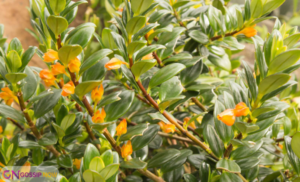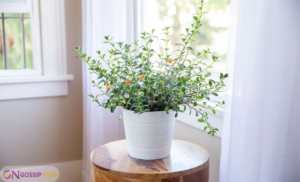If you’re searching for a unique and vibrant addition to your indoor plant collection, the goldfish plant deserves your attention. Known for its lush foliage and adorable orange flowers that resemble tiny goldfish, this plant easily wins hearts. Many plant lovers consider the goldfish_plant a favorite not only for its charm but also for its relatively easy care. Because it thrives indoors and provides a splash of color year-round, it continues to gain popularity in homes across the globe.
Right from the beginning, you’ll notice the goldfish plant stands out. Its glossy leaves and trailing stems make it perfect for hanging baskets or decorative pots on a bright windowsill. So, whether you’re a beginner or a seasoned plant enthusiast, caring for this beauty is both rewarding and fun.
What Is a Goldfish Plant?
 The goldfish_plant, scientifically known as Nematanthus gregarius, belongs to the Gesneriaceae family. As the name suggests, its flowers bear a strong resemblance to goldfish — especially when in full bloom. Native to Central and South America, particularly the cloud forests of Brazil and Costa Rica, this plant thrives in humid, warm environments with dappled sunlight.
The goldfish_plant, scientifically known as Nematanthus gregarius, belongs to the Gesneriaceae family. As the name suggests, its flowers bear a strong resemblance to goldfish — especially when in full bloom. Native to Central and South America, particularly the cloud forests of Brazil and Costa Rica, this plant thrives in humid, warm environments with dappled sunlight.
Because of its unique appearance and playful aesthetic, the indoor goldfish plant has become a staple in decorative gardening and plant enthusiast circles.
Goldfish Plant Care: How to Keep It Thriving
1. Light Requirements
To ensure vibrant growth and regular blooming, the goldfish_plant light requirements must be met properly. Place the plant in a bright, indirect light spot — such as near a south or east-facing window. Too much direct sunlight causes leaf burn, while low light slows down flowering.
Pro Tip: Use sheer curtains to filter harsh rays while still meeting your plant’s sunlight needs.
2. Watering Routine
Water plays a crucial role in goldfish_plant care. However, overwatering leads to root rot, which harms the plant more than underwatering.
-
Water thoroughly once the top inch of soil dries out
-
Use room temperature water
-
Reduce watering during winter months
Because the goldfish-plant is slightly drought-tolerant, consistent but moderate watering keeps it happy.
3. Humidity and Temperature
Since it comes from tropical regions, the goldfish_plant prefers high humidity and warmth. Aim for 60% humidity or higher.
-
Keep temperatures between 65°F–75°F
-
Mist the leaves regularly or use a humidity tray
-
Avoid placing the plant near cold drafts or heaters
Warm, humid conditions encourage lush growth and regular flowering.
4. Soil and Fertilizer
Well-draining, rich soil helps this plant flourish. Choose a potting mix that combines peat moss, perlite, and vermiculite.
-
Fertilize twice a month during the growing season (spring and summer)
-
Use a balanced, water-soluble fertilizer
-
Avoid overfeeding during fall and winter
With proper feeding, you’ll enjoy continuous blooms and healthy foliage.
Propagate Goldfish Plant Like a Pro
Propagation is not only simple but also satisfying. Here’s how to propagate goldfish_plant successfully:
Stem Cuttings Method:
-
Choose a healthy, non-flowering stem
-
Cut a 3–4 inch section just below a leaf node
-
Remove lower leaves, leaving only 2–3 at the top
-
Place the cutting in water or moist potting mix
-
Cover with a plastic dome or bag to retain humidity
Roots typically form within 2–4 weeks. Once established, transplant your cutting into a pot with well-draining soil. Because propagation is easy, you can create multiple plants to share or decorate your space even more.
Popular Goldfish Plant Varieties
With so many cultivars available, choosing your favorite goldfish plant variety becomes a fun challenge. Here are a few standout options:
1. Black Goldfish Plant
Despite the name, the black goldfish_plant doesn’t produce black flowers. Instead, it features darker, almost purple-tinged foliage and deeper orange blooms. This variety adds a dramatic touch to any plant shelf.
2. Nematanthus ‘Tropicana’
This variety showcases bright green leaves with golden-orange blooms. The contrast offers a bold, tropical vibe that suits modern indoor settings perfectly.
3. Nematanthus ‘Lollipop’
With compact growth and a burst of vivid orange blossoms, this dwarf version works well for smaller spaces.
Goldfish Plant Benefits You Should Know
Although mainly grown for its looks, the goldfish_plant offers other subtle benefits:
-
Air Purification: Like many indoor plants, it helps filter air pollutants.
-
Stress Relief: The bright flowers and lush foliage boost mood and reduce anxiety.
-
Decor Enhancement: Trailing stems and colorful blooms add a touch of charm to any room.
Because of these advantages, it’s easy to understand why this plant continues to gain fans.
Troubleshooting Common Issues
No plant is immune to occasional issues. However, with prompt attention, most problems can be fixed.
Yellowing Leaves
Often caused by overwatering or poor drainage. Adjust your watering schedule and check for soggy soil.
Wilting or Drooping
Could indicate either under-watering or exposure to cold drafts. Keep the plant in a warm, stable environment.
Lack of Blooms
This typically results from low light. Ensure your plant receives bright, indirect sunlight year-round.
Styling Your Indoor Goldfish Plant
 Because this plant trails so beautifully, styling it becomes a joy. Here are some creative placement ideas:
Because this plant trails so beautifully, styling it becomes a joy. Here are some creative placement ideas:
-
Hanging baskets in sunrooms or kitchens
-
Macrame plant hangers for a boho look
-
Mounted wall planters near windows
-
Centerpiece in a sunny living room nook
Pair it with other tropical plants like pothos or calatheas for a lush, indoor jungle vibe.
Repotting and Pruning Tips
To keep your goldfish_plant happy and neat, repot and prune regularly.
-
Repot every 2–3 years or when root-bound
-
Choose a pot just one size up
-
Prune leggy growth in early spring to promote bushiness
-
Pinch tips to encourage branching
Because pruning triggers new growth, it ensures a fuller, more vibrant plant.
Author Bio Table
| Name | Maya Greene |
|---|---|
| Profession | Indoor Plant Specialist |
| Expertise | Houseplant Care, Tropical Varieties |
| Experience | 10+ Years in Urban Gardening |
| Favorite Plant | Goldfish Plant |
| Socials | @plantmama_maya |
Final Thoughts
All things considered, the goldfish_plant is a joy to grow and display. With its cascading stems, shiny leaves, and quirky fish-shaped blooms, this tropical beauty brings fun and elegance into any indoor space.
Whether you’re seeking a conversation-starter plant or just want to add color to your plant shelf, this one checks all the boxes. So, go ahead and bring a goldfish_plant into your home — you’ll quickly see why it continues to charm plant lovers everywhere.
After all, few plants deliver so much character with so little fuss. Because of that, it’s no wonder the indoor goldfish_plant remains a must-have in 2025 and beyond.
FAQs
1. How often should I water a goldfish plant?
Water only when the top inch of soil feels dry. During cooler months, reduce the frequency slightly to prevent overwatering.
2. Can I grow a goldfish plant in low light?
While it survives in low light, it blooms best in bright, indirect sunlight. So, always place it near a sunny window for ideal growth.
3. What is the easiest way to propagate a goldfish plant?
Stem cuttings placed in water or moist soil root quickly. Therefore, it’s the most effective method for propagation.
4. Are goldfish plants safe for pets?
Yes, generally speaking, the goldfish_plant is considered non-toxic to cats and dogs. Even so, discourage nibbling to avoid digestive upset.
5. Why aren’t my goldfish plant flowers blooming?
Insufficient light, overfeeding, or lack of humidity often cause bloom issues. Make sure your plant receives the right care to promote flowering.






